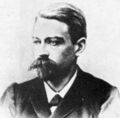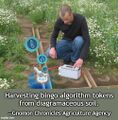Template:Selected anniversaries/December 29: Difference between revisions
No edit summary |
No edit summary |
||
| Line 1: | Line 1: | ||
<gallery> | <gallery> | ||
||Maria Margaretha Kirch | ||1720: Maria Margaretha Kirch dies ... astronomer, and one of the first famous astronomers of her period due to her writings on the conjunction of the sun with Saturn, Venus, and Jupiter in 1709 and 1712 respectively. Calendar pic. | ||
||1731 | ||1731: Brook Taylor dies ... mathematician and theorist. | ||
||1737 | ||1737: Joseph Saurin dies ... minister and mathematician. | ||
||1766 | ||1766: Charles Macintosh born ... chemist and the inventor of waterproof fabric. | ||
File:Supplice de 9 émigrés Octobre 1793.jpg|link=French Revolution (nonfiction)|1786: [[French Revolution (nonfiction)|French Revolution]]: The Assembly of Notables is convened. | File:Supplice de 9 émigrés Octobre 1793.jpg|link=French Revolution (nonfiction)|1786: [[French Revolution (nonfiction)|French Revolution]]: The Assembly of Notables is convened. | ||
||1796 | ||1796: Johann Christian Poggendorff born ... physicist and journalist. | ||
||1800 | ||1800: Charles Goodyear born ... chemist and engineer. | ||
File:Thomas Joannes Stieltjes.jpg|link=Thomas Joannes Stieltjes (nonfiction)|1856: Mathematician [[Thomas Joannes Stieltjes (nonfiction)|Thomas Joannes Stieltjes]] born. He will work on almost all branches of analysis, continued fractions and number theory, will be called "the father of the analytic theory of continued fractions." | File:Thomas Joannes Stieltjes.jpg|link=Thomas Joannes Stieltjes (nonfiction)|1856: Mathematician [[Thomas Joannes Stieltjes (nonfiction)|Thomas Joannes Stieltjes]] born. He will work on almost all branches of analysis, continued fractions and number theory, will be called "the father of the analytic theory of continued fractions." | ||
||1860 | ||1860: The launch of HMS Warrior, with her combination of screw propeller, iron hull and iron armour, renders all previous warships obsolete. | ||
||Kurt Wilhelm Sebastian Hensel | ||1861: Kurt Wilhelm Sebastian Hensel born ... mathematician. | ||
File:Leopold Kronecker 1865.jpg|link=Leopold Kronecker (nonfiction)|1891: Mathematician [[Leopold Kronecker (nonfiction)|Leopold Kronecker]] dies. His work included number theory, algebra, and logic. | File:Leopold Kronecker 1865.jpg|link=Leopold Kronecker (nonfiction)|1891: Mathematician [[Leopold Kronecker (nonfiction)|Leopold Kronecker]] dies. His work included number theory, algebra, and logic. | ||
||1908 | ||1905: Martin Wiberg dies ... philosopher and engineer ... computer pioneer for his c. 1859 (1857-1860) invention of a machine the size of a sewing machine that could print logarithmic tables (first interest tables appeared in 1860, logarithmic in 1875). Pic. | ||
||1908: Magnus Pyke born ... scientist and author. | |||
File:Klaus Fuchs.jpg|link=Emil Julius Klaus Fuchs (nonfiction)|1911: Physicist [[Emil Julius Klaus Fuchs (nonfiction)|Emil Julius Klaus Fuchs]] born. He will be convicted of supplying information from the Manhattan Project to the Soviet Union during and shortly after the Second World War. | File:Klaus Fuchs.jpg|link=Emil Julius Klaus Fuchs (nonfiction)|1911: Physicist [[Emil Julius Klaus Fuchs (nonfiction)|Emil Julius Klaus Fuchs]] born. He will be convicted of supplying information from the Manhattan Project to the Soviet Union during and shortly after the Second World War. | ||
||Jürgen Ehlers | ||Jürgen Ehlers born ... physicist who contributed to the understanding of Albert Einstein's theory of general relativity. Pic. | ||
File:Tullio Levi-civita.jpg|link=Tullio Levi-Civita (nonfiction)|1941: Mathematician and academic [[Tullio Levi-Civita (nonfiction)|Tullio Levi-Civita]] dies. He gained fame for his work on absolute differential calculus (tensor calculus) and its applications to the theory of relativity, and made significant contributions in other areas. | File:Tullio Levi-civita.jpg|link=Tullio Levi-Civita (nonfiction)|1941: Mathematician and academic [[Tullio Levi-Civita (nonfiction)|Tullio Levi-Civita]] dies. He gained fame for his work on absolute differential calculus (tensor calculus) and its applications to the theory of relativity, and made significant contributions in other areas. | ||
| Line 32: | Line 34: | ||
File:Diagramaceous soil bingo algorithm harvest.jpg|link=Diagramaceous soil|1943: Bingo tokens harvested from [[diagramaceous soil]] using new class of [[Gnomon algorithm functions]]. | File:Diagramaceous soil bingo algorithm harvest.jpg|link=Diagramaceous soil|1943: Bingo tokens harvested from [[diagramaceous soil]] using new class of [[Gnomon algorithm functions]]. | ||
||1947 | ||1947: Richard Crandall born ... physicist and computer scientist. | ||
||1949 | ||1949: KC2XAK of Bridgeport, Connecticut becomes the first Ultra high frequency (UHF) television station to operate a daily schedule. | ||
||Tibor Radó | ||1965: Tibor Radó dies ... Hungarian mathematician. Pic. | ||
File:Paul Sally 2008.jpg|link=Paul Sally (nonfiction)|1993: Mathematician, academic, and crime-fighter [[Paul Sally (nonfiction)|Paul Sally]] publishes new class of [[Gnomon algorithm functions]] which use p-adic analysis and representation theory to detect and prevent [[crimes against mathematical constants]]. | File:Paul Sally 2008.jpg|link=Paul Sally (nonfiction)|1993: Mathematician, academic, and crime-fighter [[Paul Sally (nonfiction)|Paul Sally]] publishes new class of [[Gnomon algorithm functions]] which use p-adic analysis and representation theory to detect and prevent [[crimes against mathematical constants]]. | ||
||2004 | ||2004: Julius Axelrod dies ... biochemist and academic, Nobel Prize laureate. | ||
||2012 | ||2012: Bruce Stark dies ... cartoonist. | ||
||Erhard Heinz | ||2017: Erhard Heinz dies ... mathematician known for his work on partial differential equations, in particular the Monge–Ampère equation. In 1994 he was awarded the Cantor medal. Pic. | ||
</gallery> | </gallery> | ||
Revision as of 16:16, 24 September 2018
1786: French Revolution: The Assembly of Notables is convened.
1856: Mathematician Thomas Joannes Stieltjes born. He will work on almost all branches of analysis, continued fractions and number theory, will be called "the father of the analytic theory of continued fractions."
1891: Mathematician Leopold Kronecker dies. His work included number theory, algebra, and logic.
1911: Physicist Emil Julius Klaus Fuchs born. He will be convicted of supplying information from the Manhattan Project to the Soviet Union during and shortly after the Second World War.
1941: Mathematician and academic Tullio Levi-Civita dies. He gained fame for his work on absolute differential calculus (tensor calculus) and its applications to the theory of relativity, and made significant contributions in other areas.
1943: Bingo tokens harvested from diagramaceous soil using new class of Gnomon algorithm functions.
1993: Mathematician, academic, and crime-fighter Paul Sally publishes new class of Gnomon algorithm functions which use p-adic analysis and representation theory to detect and prevent crimes against mathematical constants.






